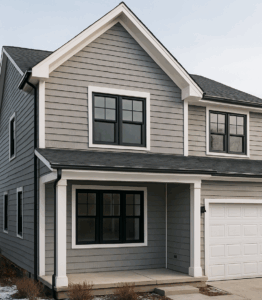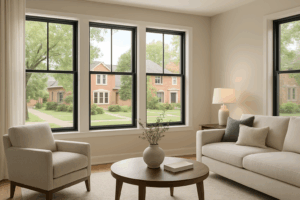How Chicago’s Winters Test Your Home’s Siding
If you’ve lived through a Chicago winter, you know the elements are no joke. Between subzero wind chills, ice buildup, and rapid freeze-thaw cycles, your home’s exterior takes a serious beating.
That’s why choosing the right siding material isn’t just about looks — it’s about long-term performance. The two most popular options, vinyl and composite siding, each bring unique benefits. But which one truly holds up better in Greater Chicago’s harsh climate?
Let’s break it down.

Vinyl Siding — Affordable, Reliable, and Time-Tested
Vinyl siding remains the most common choice for Chicago-area homes, from Schaumburg to Naperville. Its biggest appeal? Cost-effectiveness and low maintenance.
The Benefits
- Budget-Friendly: Vinyl siding typically costs $6–$10 per sq. ft. installed, making it one of the most affordable exterior upgrades.
- Weather-Resistant: Quality vinyl siding resists moisture and won’t rot like wood.
- Easy Maintenance: Just a gentle wash once or twice a year keeps it looking clean.
- Color Variety: Available in dozens of hues and profiles to match any style.
The Drawbacks
Vinyl’s flexibility can also be a weakness. During extreme cold, panels can become brittle and may crack or warp with temperature fluctuations. Over many winters, that can lead to gaps and reduced insulation.
Insulated vinyl siding (with built-in foam backing) performs better but still can’t match the rigidity or thermal stability of composite alternatives.
Composite Siding — Built for Strength and Longevity
Composite siding, often made from engineered wood fibers and resins, is a newer generation of exterior protection designed for durability. It’s particularly popular in high-performance remodels across suburbs like Naperville, Bolingbrook, and Roselle.
The Benefits
- Superior Durability: Composite materials resist cracking, warping, and moisture penetration.
- Enhanced Insulation: Helps maintain stable indoor temperatures, even during lake-effect cold snaps.
- High-End Aesthetic: Mimics real wood texture while staying uniform and maintenance-free.
- Longevity: Properly installed composite siding can last 30–40 years with minimal upkeep.
The Drawbacks
- Higher Initial Cost: Expect $10–$16 per sq. ft. installed, depending on brand and finish.
- Professional Installation Required: Precision fitting and sealing are key for long-term performance.
While the upfront investment is higher, many Chicago homeowners find composite siding pays for itself in reduced repairs, repainting, and energy savings over time.
Performance in Chicago’s Winter Climate
| Feature | Vinyl Siding | Composite Siding |
|---|---|---|
| Cold Resistance | Moderate (can crack under extreme cold) | Excellent (rigid and temperature stable) |
| Moisture Resistance | High | Very High |
| Insulation Value | Good (especially insulated models) | Excellent |
| Impact Resistance | Fair | Strong |
| Lifespan | 20–25 years | 30–40 years |
For homes that experience repeated freeze-thaw cycles or face strong lake winds, composite siding’s dimensional stability makes it the more reliable long-term choice.
Appearance and Curb Appeal
Both vinyl and composite siding offer impressive visual options, but composite siding edges out when it comes to premium finish and realism.
Vinyl panels can sometimes show seams or fading over time, while composite boards feature deeper embossing and UV-resistant coatings that retain their color longer. If you’re aiming for a modern, upscale aesthetic—especially in areas like Lincoln Park, Naperville, or Elmhurst—composite often delivers the look and feel of painted wood without the upkeep.
Installation and Maintenance Considerations
Vinyl siding can be installed quickly and easily, even over some existing materials, making it ideal for budget-friendly remodels.
Composite siding, however, requires precise installation techniques to maintain waterproof seals and expansion joints. Midwest Windows, Siding & Doors ensures each board is perfectly aligned and weatherproofed—critical for long-term performance in Chicago’s unpredictable conditions.
Once installed, composite siding only needs an occasional rinse, no repainting, and virtually no maintenance beyond that.
Cost vs. Longevity — The Real Value
While vinyl may save you money upfront, the longer lifespan and stability of composite siding often make it the better value over decades.
For example, homeowners who plan to stay in their property for 15+ years typically find composite siding offers the best ROI through reduced repairs and energy efficiency gains.
The Verdict
If your top priorities are affordability and ease, vinyl siding remains a solid option.
But if you want a siding material that can withstand Chicago’s toughest winters, maintain its color, and improve insulation, composite siding is the smarter, longer-lasting investment.
Protect your home from Chicago’s toughest weather with siding that lasts.
Schedule your free siding consultation today with Midwest Windows, Siding & Doors.








